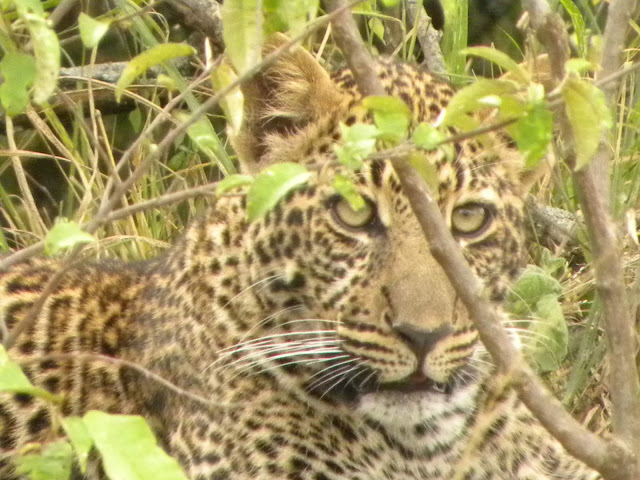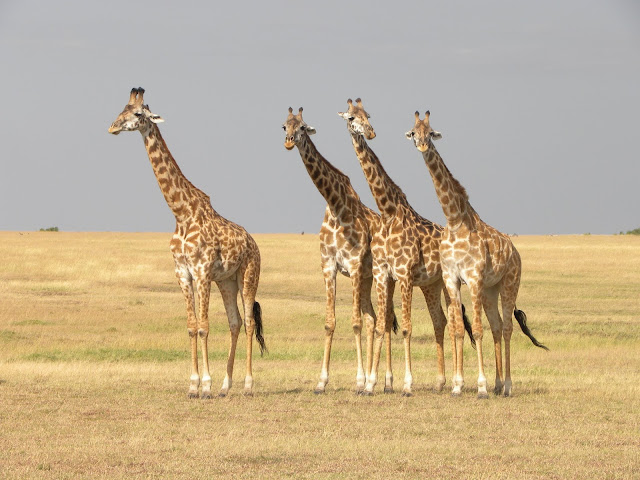Weather
Very
wet, heavy rains. It gets sunny in the
morning followed by thunderstorms in the afternoon. Nevertheless there have
been some spectacular sunsets and sunrises and on some clear nights, the moon
rise.
Temperature: 12ºc -18ºc.
Wildlife
Fantastic.
The
park is lush with grass and all the watering holes are full. The elephants are having a great time with
big herds that have never been seen before including the big bulls with big
tuskers who we believe are not resident in the park but come from the Nyakweri
forest on top of the Oloololo escarpment north-west of Mara Intrepids and Mara
Explorer Camps.
There
are also many female elephants with some very young calves.
Buffalos are also having a great
time and most of them are with calves. There are hundreds of them around.
The
smaller antelopes like the Thompson gazelles, Grants gazelle, impalas, and the
topi have moved to higher grounds where the grass is a bit shorter. It’s safer
for them.
For
bird watchers this is a very good time. The
Widow birds are in breeding plumage. Easily seen are Pin tailed whydahs,
European white storks, White-faced whistling ducks with ducklings, Saddle-billed
storks, and Secretary birds.
Predators
Lions
Olkiombo Pride
It is
slowly falling back to its original territory along the Talek River. The pride
has been moving to the north where the grass is shorter and easier to hunt. The
lions have attacked some cows from the herders in the park. The dominant males,
Maridadi and Kaka are still in charge of the pride.
Ridge Pride
Intact
with Blacky and Lipstick in charge.
The
pride is still at Topi Plains on the northern side of Rhino Ridge.
The
grass is taller here so the lions are having a difficult time hunting. But they
have had some success with warthogs and topis.
Enkuyanai Pride with Oloolpapit and
Olbarnoti are doing okay. It killed a buffalo on the eastern side of Ntiakitiak
River and devoured it in three days.
It then
moved back across Ntiakitiak River and is now at Kaboso trying to hunt zebras.
Leopards
Bahati seems to have separated from
her cubs. She was last seen mating with one of the resident males along the
Olare Orok River. She may have another litter sometime in August.
Bahati’s
cubs Hatari (male) and Bella2 (female) named after her great grandmother Bella are
doing very well, hunting smaller prey like baby impala.
The
Kaboso female is also doing great
with her cubs in their territory along Kaboso River and Nkorbob. The river is
very high and impassable but when we managed to cross the river, we saw them
with a warthog up on a tree.
Cheetahs
The
five male cheetahs are at Maji ya Fisi.
They were last seen with a female cheetah named Nora after which they separated from the female.
They
moved across the Talek River into Olare Orok Conservancy but didn’t stay long there
because of the number of domestic cows that have been allowed to graze in the
conservancy.
Imani has lost three of her four
cubs. She is trying very hard to protect the surviving cub. They crossed the
Talek River in late April and are around Murram ya Fig Tree and Lugga ya
Njoroge. Imani has been successful in
hunting on several occasions.
Malaika’s male cubs are around Rekero
and Lugga ya Ndege, trying to hunt, getting better by the day.
Sightings
by Raphael Koikai, head driver-guide


























































